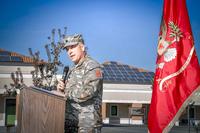ØRLAND, Norway -- The first-ever Exercise Arctic Challenge, which includes more than 60 aircraft from five partner nations, here began Sept. 16.
Norwegian F-16 Fighting Falcons, Swedish JAS-39 Gripens, Finnish F/A-18 Hornets and U.K. Eurofighter Typhoons took to the skies with U.S. Air Force F-15E Strike Eagles, F-15C Eagles and KC-135 Stratotankers to train in a combined environment. They incorporated both strategic planning and tactical war fighting simulations, practicing in-flight maneuvers and communication strategies with each other.
Two NATO E-3A AWACS aircraft also joined in to provided aerial combat command for the dueling aircraft further simulating a real combat scenario.
"[Our] air force has, in periods, had the need to train at bigger scenarios with more aircraft, and this is difficult in Norway, with only our own planes at [our] disposal," said Col. Baid Solheim, Main Air Station Bodø base commander. "Before the cross border training we had to deploy to foreign, far away countries to fly against other types of aircraft, [now] we fly directly from Bodø. In this way it's very efficient in costs."
The Arctic Challenge exercise focused on bringing the Scandinavian nations, the U.S. and the U.K. together in the air, to challenge pilots to react quickly and work together to achieve common goals. During times of maximum participation, more than 60 aircraft are expected to partake in the war-fighting scenarios.
"During this exercise, we will face almost every scenario that could be seen in any war or conflict," said U.S. Air Force Maj. Rich Stringer, 494th Fighter Squadron assistant director of operations and lead project officer for the 48th Fighter Wing's participation in the exercise. The different aircraft will take turns as the aggressors and will be tested on how they can respond to a variety of scenarios, according to Stringer.
The purpose of this exercise is to train air forces to operate cohesively. Arctic Challenge, in particular, allows multiple nations to perform aerial operations simultaneously; give critical feedback on how to improve processes; and become a more efficient and effective force -- especially in a multi-national environment.
"These exercises provide the U.S. and NATO forces an opportunity to integrate their operations at both the tactical and strategic levels with a high level of fidelity that could not otherwise be achieved without live-fly exercises," said Capt. Timothy Gerne, 100th Operations Support Squadron chief of wing weapons and tactics and director of operations for the 100th Air Refueling Wing portion of the exercise. "Similar to a Red Flag exercise in mission sets, large force numbers and multinational integration, the benefits of hosting locally allows us and our allies to focus resources toward operations."
In addition to flying with allies, Airmen on MAS Bodø and MAS Ørland combined the exercise with a simulated deployment. The movement tested many assets in U.S. Air Forces in Europe including air lift, medical, legal and financial services.
"This exercise improves the readiness of everyone because of the variety of scenarios and the high level of skill that we are flying with and against," said Stringer. "The Finns, Swedes, British, and Norwegians are all very skilled aviators and have very competent forces."
The Arctic Challenge exercise is scheduled to continue until Sept. 26, before culminating in a final scenario which tests the pilots on their ability to operate in a diverse force.



























